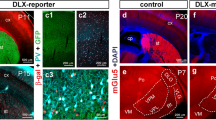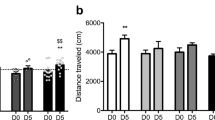Abstract
Background
Major inter-individual differences exist in vulnerability to anxiety and affective disorders, and the underlying neurobiology could help in understanding the predisposition to these disorders and treatment resistance. Recently the glutamatergic system has become a target in the development of novel antidepressants.
Methods
We compared extracellular glutamate levels in low (LE-) and high exploring (HE-) rats in hippocampus and striatum at baseline and after inhibition of re-uptake by perfusion with l-trans-pyrrolidine-2,4-dicarboxylate (PDC, 4 mM). Glutamate levels in microdialysates were measured by HPLC after derivatization.
Results
In the striatum, baseline glutamate levels in young adult LE-rats and HE-rats were not significantly different, but the response to uptake inhibition was: perfusion with PDC increased extracellular glutamate levels in both LE- and HE-rats, but to a significantly lower extent in LE-rats. Although the characteristic levels of exploration of LE- and HE-rats had previously been shown to be stable up to 8 months of age, we identified a subgroup of HE-rats whose exploration levels had drastically dropped by age of 11 months (formerly HE-rats, HEF), and analyzed their data separately. There were no differences in the PDC-evoked striatal glutamate release between the three groups; however, the baseline glutamate levels were higher in the HEF-subgroup compared to the HE- and LE-animals. In the CA1 area of hippocampus, there were no differences in extracellular glutamate levels between the LE- and HE-rats either at baseline or after inhibition of uptake.
Conclusion
These results suggest that inter-individual differences in exploratory behaviour may be related to striatal glutamatergic neurotransmission.
Similar content being viewed by others
Abbreviations
- EAAT2:
-
excitatory amino acid (glutamate) transporter 2
- 5-HT:
-
serotonin
- HEF:
-
formerly high explorer
- HE:
-
high explorer
- LE:
-
low explorer
- PDC:
-
l-trans-pyrrolidine-2,4-dicarboxylic acid
References
Hariri AR. The neurobiology of individual differences in complex behavioral traits. Annu Rev Neurosci 2009;32:225–47.
Harro J. Inter-individual differences in neurobiology as vulnerability factors for affective disorders: implications for psychopharmacology. Pharmacol Ther 2010;125(3):402–22.
Rosenzweig-Lipson S, Beyer CE, Hughes ZA, Khawaja X, Rajarao SJ, Malberg JE, et al. Differentiating antidepressants of the future: efficacy and safety. Pharmacol Ther 2007;113(1):134–53.
Racagni G, Popoli M. Cellular and molecular mechanisms in the long-term action of antidepressants. Dialogues Clin Neurosci 2008;10(4):385–400.
Skolnick P, Popik P, Trullas R. Glutamate-based antidepressants: 20 years on. Trends Pharmacol Sci 2009;30(11):563–9.
Tokita K, Yamaji T, Hashimoto K. Roles of glutamate signaling in preclinical and/ or mechanistic models of depression. Pharmacol Biochem Behav 2012;100(4): 688–704.
Zarate C, Machado-Vieira R, Henter I, Ibrahim L, Diazgranados N, Salvadore G. Glutamatergic modulators: the future of treating mood disorders? Harv Rev Psychiatry 2010;18(5):293–303.
Danbolt NC. Glutamate uptake. Prog Neurobiol 2001;65(1):1–105.
Bergles DE, Diamond JS, Jahr CE. Clearance of glutamate inside the synapse and beyond. Curr Opin Neurobiol 1999;9(3):293–8.
Clements JD, Lester RA, Tong G, Jahr CE, Westbrook GL. The time course of glutamate in the synaptic cleft. Science 1992;258(5087):1498–501.
Neuhauss SCF, Rico EP, Gesemann M. Nomenclature of glutamate transporters in zebrafish and other vertebrates. Brain Res Bull 2010;83(6):297.
Shigeri Y, Seal RP, Shimamoto K. Molecular pharmacology of glutamate transporters, EAATs and VGLUTs. Brain Res Rev 2004;45(3):250–65.
Mitchell ND, Baker GB. An update on the role of glutamate in the pathophysiology of depression. Acta Psychiatr Scand 2010;122(3):192–210.
Zink M, Vollmayr B, Gebicke-Haerter PJ, Henn FA. Reduced expression of glutamate transporters vGluT1, EAAT2 and EAAT4 in learned helpless rats, an animal model of depression. Neuropharmacology 2010;58(2):465–73.
Almeida RF, Thomazi AP, Godinho GF, Saute JAM, Wofchuk ST, Souza DO, et al. Effects of depressive-like behavior of rats on brain glutamate uptake. Neurochem Res 2010;35(8):1164–71.
Chen J-X, Yao L-H, Xu B-B, Qian K, Wang H-L, Liu Z-C, et al. Glutamate transporter 1-mediated antidepressant-like effect in a rat model of chronic unpredictable stress. J Huazhong Univ Sci Technol Med Sci 2014;34(6):838–44.
Gourley SL, Espitia JW, Sanacora G, Taylor JR. Antidepressant-like properties of oral riluzole and utility of incentive disengagement models of depression in mice. Psychopharmacology (Berl) 2012;219(3):805–14.
Zink M, Rapp S, Donev R, Gebicke-Haerter PJ, Thome J. Fluoxetine treatment induces EAAT2 expression in rat brain. J Neural Transm 2011;118(6):849–55.
Reagan LP, Rosell DR, Wood GE, Spedding M, Muñoz C, Rothstein J, et al. Chronic restraint stress up-regulates GLT-1 mRNA and protein expression in the rat hippocampus: reversal by tianeptine. Proc Natl Acad Sci U S A 2004;101(7):2179–84.
Otter MH, Matto V, Sõukand R, Skrebuhhova T, Allikmets L, Harro J. Characterization of rat exploratory behavior using the exploration box test. Methods Find Exp Clin Pharmacol 1997;19(10):683–91.
Ma¨llo T, Alttoa A, Kõiv K, Tõnissaar M, Eller M, Harro J. Rats with persistently low or high exploratory activity: behaviour in tests of anxiety and depression, and extracellular levels of dopamine. Behav Brain Res 2007;177(2):269–81.
Ma¨llo T, Kõiv K, Koppel I, Raudkivi K, Uustare A, Rinken A, et al. Regulation of extracellular serotonin levels and brain-derived neurotrophic factor in rats with high and low exploratory activity. Brain Res 2008;1194(5):110–7.
Alttoa A, Seeman P, Kõiv K, Eller M, Harro J. Rats with persistently high exploratory activity have both higher extracellular dopamine levels and higher proportion of D(2) (High) receptors in the striatum. Synapse 2009;63(5): 443–6.
Matrov D, Kolts I, Harro J. Cerebral oxidative metabolism in rats with high and low exploratory activity. Neurosci Lett 2007;413(2):154–8.
Alttoa A, Kõiv K, Hinsley TA, Brass A, Harro J. Differential gene expression in a rat model of depression based on persistent differences in exploratory activity. Eur Neuropsychopharmacol 2010;20(5):288–300.
Umegaki H, Roth GS, Ingram DK. Aging of the striatum: mechanisms and interventions. Age 2008;30(4):251–61.
Del Arco A, Segovia G, Prieto L, Mora F. Endogenous glutamate–taurine interaction in striatum and nucleus accumbens of the freely moving rat: studies during the normal process of aging. Mech Ageing Dev 2001;122(4):401–14.
Corsi C, Pazzagli M, Bianchi L, Della Corte L, Pepeu G, Pedata F. In vivo amino acid release from the striatum of aging rats: adenosine modulation. Neurobiol Aging 1997;18(2):243–50.
Freeman GB, Gibson GE. Selective alteration of mouse brain neurotransmitter release with age. Neurobiol Aging 1987;8(2):147–52.
Massieu L, Tapia R. Glutamate uptake impairment and neuronal damage in young and aged rats in vivo. J Neurochem 1997;69(3):1151–60.
Zhang WQ, Mundy WR, Thai L, Hudson PM, Gallagher M, Tilson HA, et al. Decreased glutamate release correlates with elevated dynorphin content in the hippocampus of aged rats with spatial learning deficits. Hippocampus 1991;1(4):391–7.
Harro J. Animal models of depression vulnerability. Curr Top Behav Neurosci 2013;14:29–54.
Behrens PF, Franz P, Woodman B, Lindenberg KS, Landwehrmeyer GB. Impaired glutamate transport and glutamate-glutamine cycling: downstream effects of the Huntington mutation. Brain 2002;125(8):1908–22.
Bridges RJ, Stanley MS, Anderson MW, Cotman CW, Chamberlin AR. Conformationally defined neurotransmitter analogues. Selective inhibition of glutamate uptake by one pyrrolidine-2,4-dicarboxylate diastereomer. J Med Chem 1991;34(2):717–25.
Waldmeier PC, Wicki P, Feldtrauer JJ. Release of endogenous glutamate from rat cortical slices in presence of the glutamate uptake inhibitor L-trans-pyrrolidine-2,4-dicarboxylic acid. Naunyn Schmiedebergs Arch Pharmacol 1993;348(5):478–85.
Paxinos G, Watson C. The rat brain in stereotaxic coordinates. 2nd ed. San Diego: Academic Press; 1986.
Kehr J. Handbook of microdialysis – methods applications and perspectives, vol. 16. Elsevier; 2006.
Donzanti BA, Yamamoto BK. An improved and rapid HPLC-EC method for the isocratic separation of amino acid neurotransmitters from brain tissue and microdialysis perfusates. Life Sci 1988;43(11):913–22.
Ho YJ, Chang YC, Liu TM, Tai MY, Wong CS, Tsai YF. Striatal glutamate release during novelty exposure-induced hyperactivity in olfactory bulbectomized rats. Neurosci Lett 2000;287(2):117–20.
Shakil SS, Holmer HK, Moore C, Abernathy AT, Jakowec MW, Petzinger GM, et al. High and low responders to novelty show differential effects in striatal glutamate. Synapse 2005;58(3):200–7.
Chefer V, Meis J, Wang G, Kuzmin A, Bakalkin G, Shippenberg T. Repeated exposure to moderate doses of ethanol augments hippocampal glutamate neurotransmission by increasing release. Addict Biol 2011;16(2):229–37.
Takeda A,Sakurada N,Kanno S,Minami A,Oku N. Response of extracellular zinc in the ventral hippocampus against novelty stress. J Neurochem 2006;99(2): 670–6.
Smith AD, Bolam JP. The neural network of the basal ganglia as revealed by the study of synaptic connections of identified neurones. Trends Neurosci 1990; 13(7):259–65.
Shimizu N, Duan SM, Hori T, Oomura Y. Glutamate modulates dopamine release in the striatum as measured by brain microdialysis. Brain Res Bull 1990;25(1):99–102.
Mora F, Del Arco A, Segovia G. Glutamate–dopamine interactions in striatum and nucleus accumbens of the conscious rat during aging. In: Graybiel A, Delong M, Kitai S, editors. Basal Ganglia VI SE – 61, vol. 54. US: Springer; 2003.
Yamamoto BK, Davy S. Dopaminergic modulation of glutamate release in striatum as measured by microdialysis. J Neurochem 1992;58(5):1736–42.
Massie A, Goursaud S, Schallier A, Vermoesen K, Meshul CK, Hermans E, et al. Time-dependent changes in GLT-1 functioning in striatum of hemi-Parkinson rats. Neurochem Int 2010;57(5):572–8.
Chung EKY, Chen LW, Chan YS, Yung KKL. Downregulation of glial glutamate transporters after dopamine denervation in the striatum of 6-hydroxydopamine-lesioned rats. J Comp Neurol 2008;511(4):421–37.
Vollbrecht PJ, Simmler LD, Blakely RD, Deutch AY. Dopamine denervation of the prefrontal cortex increases expression of the astrocytic glutamate transporter GLT-1. J Neurochem 2014;130(1):109–14.
Bianchi L, Ballini C, Colivicchi MA, Della Corte L, Giovannini MG, Pepeu G. Investigation on acetylcholine, aspartate, glutamate and GABA extracellular levels from ventral hippocampus during repeated exploratory activity in the rat. Neurochem Res 2003;28(3–4):565–73.
Giovannini MG, Rakovska A, Benton RS, Pazzagli M, Bianchi L, Pepeu G. Effects of novelty and habituation on acetylcholine, GABA, and glutamate release from the frontal cortex and hippocampus of freely moving rats. Neuroscience 2001;106(1):43–53.
Harro J, Kanarik M, Matrov D, Panksepp J. Mapping patterns of depressionrelated brain regions with cytochrome oxidase histochemistry: relevance of animal affective systems to human disorders, with a focus on resilience to adverse events. Neurosci Biobehav Rev 2011;35(9):1876–89.
Fanselow MS, Dong H-W. Are the dorsal and ventral hippocampus functionally distinct structures? Neuron 2010;65(1):7–19.
Meldrum B, Garthwaite J. Excitatory amino acid neurotoxicity and neurodegenerative disease. Trends Pharmacol Sci 1990;11(9):379–87.
Rosenberg PA, Amin S, Leitner M. Glutamate uptake disguises neurotoxic potency of glutamate agonists in cerebral cortex in dissociated cell culture. J Neurosci 1992;12(1):56–61.
Lowy MT, Wittenberg L, Yamamoto BK. Effect of acute stress on hippocampal glutamate levels and spectrin proteolysis in young and aged rats. J Neurochem 1995;65(1):268–74.
Moghaddam B. Stress preferentially increases extraneuronal levels of excitatory amino acids in the prefrontal cortex: comparison to hippocampus and basal ganglia. J Neurochem 1993;60(5):1650–7.
Lehre KP, Levy LM, Ottersen OP, Storm-Mathisen J, Danbolt NC. Differential expression of two glial glutamate transporters in the rat brain: quantitative and immunocytochemical observations. J Neurosci 1995;15(3):1835–53.
Author information
Authors and Affiliations
Corresponding author
Additional information
These two authors contributed equally to this paper.
Rights and permissions
About this article
Cite this article
Raudkivi, K., Alttoa, A., Leito, I. et al. Differences in extracellular glutamate levels in striatum of rats with high and low exploratory activity. Pharmacol. Rep 67, 858–865 (2015). https://doi.org/10.1016/j.pharep.2015.02.002
Received:
Revised:
Accepted:
Published:
Issue Date:
DOI: https://doi.org/10.1016/j.pharep.2015.02.002




